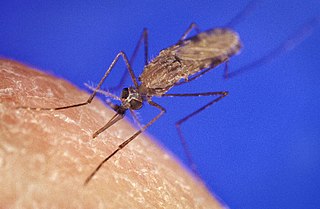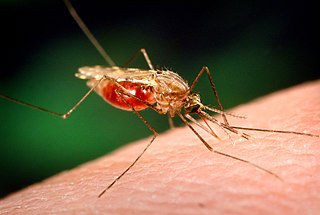
Mosquitoes, the Culicidae, are a family of small flies consisting of 3,600 species. The word mosquito is Spanish and Portuguese for little fly. Mosquitoes have a slender segmented body, one pair of wings, three pairs of long hair-like legs, and specialized, highly elongated, piercing-sucking mouthparts. All mosquitoes drink nectar from flowers; females of some species have in addition adapted to drink blood. Evolutionary biologists view mosquitoes as micropredators, small animals that parasitise larger ones by drinking their blood without immediately killing them. Medical parasitologists view mosquitoes instead as vectors of disease, carrying protozoan parasites or bacterial or viral pathogens from one host to another.

Anopheles is a genus of mosquito first described by J. W. Meigen in 1818, and are known as nail mosquitoes and marsh mosquitoes. Many such mosquitoes are vectors of the parasite Plasmodium, a genus of protozoans that cause malaria in birds, reptiles, and mammals, including humans. The Anopheles gambiae mosquito is the best-known species of marsh mosquito that transmits the Plasmodium falciparum, which is a malarial parasite deadly to human beings; no other mosquito genus is a vector of human malaria.

Ribosomal DNA (rDNA) is a DNA sequence that codes for ribosomal RNA. These sequences regulate transcription initiation and amplification, and contain both transcribed and non-transcribed spacer segments.

The Anopheles gambiae complex consists of at least seven morphologically indistinguishable species of mosquitoes in the genus Anopheles. The complex was recognised in the 1960s and includes the most important vectors of malaria in sub-Saharan Africa, particularly of the most dangerous malaria parasite, Plasmodium falciparum. It is one of the most efficient malaria vectors known. The An. gambiae mosquito additionally transmits Wuchereria bancrofti which causes lymphatic filariasis, a symptom of which is elephantiasis.

Anopheles culicifacies is a mosquito species complex and one of the primary vectors of malaria on the Indian subcontinent. It consists of five sibling species, provisionally designated as species A, B, C, D, and E. It prefers to rest indoors in cattle sheds, where it feeds on cattle. The control of A. culicifacies has become difficult due to the development of insecticide resistance against all commonly used insecticides, including new-generation insecticides such as synthetic pyrethroids.

Anopheles dirus is a vector of malaria in Asian forested zones.

Anopheles is a genus of mosquitoes (Culicidae) with about 484 recognised species.
Anopheles (Cellia) subpictus is a species complex of four species of mosquito belonging to the genus Anopheles.

Anopheles albimanus is a species of mosquito in the order Diptera. It is found in coastal Central and South America, the Caribbean, and Mexico. It is a generalist species and capable of wide dispersion. A. albimanus is a common malaria vector.

Anopheles stephensi is a primary mosquito vector of malaria in urban India and is included in the same subgenus as Anopheles gambiae, the primary malaria vector in Africa. A. gambiae consists of a complex of morphologically identical species of mosquitoes, along with all other major malaria vectors; however, A. stephensi has not yet been included in any of these complexes. Nevertheless, two races of A. stephensi exist based on differences in egg dimensions and the number of ridges on the eggs; A. s. stephensisensu stricto, the type form, is a competent malaria vector that takes place in urban areas, and A. s. mysorensis, the variety form, exists in rural areas and exhibits considerable zoophilic behaviour, making it a poor malaria vector. However, A. s. mysorensis is a detrimental vector in Iran. An intermediate form also exists in rural communities and peri-urban areas, though its vector status is unknown. About 12% of malaria cases in India are due to A. stephensi.
Anopheles kleini is a species of mosquito. It is found in South Korea. The species name honors US Army Colonel Terry A. Klein, medical entomologist, for his numerous contributions to mosquito research in Asia.

Anopheles sinensis is a species of mosquito that transmits malaria as well as lymphatic filariasis. It is regarded as the most important vector of these human parasitic diseases in Southeast Asia. It is the primary vector of vivax malaria in many regions. In China it also transmits the filalarial parasite, and arthropod roundworm. In Japan it is also a vector of a roundworm Setaria digitata in sheep and goats.

Setaria is a genus of parasitic roundworms that infect domesticated mammals such as pigs, camels, cattle and horses. Some species also infect wild mammals such as deer and antelope. The genus consists of about 43 species. Members of the genus are uniquely parasites in the abdominal cavity of the body. They are mostly large-sized roundworms, possessing an elaborate head (cephalic) region that is characterised by spines, presence of four lips, and well-guarded mouth. Little is known about their pathogenic effects, but some are known to affect nervous system and eye. The larval infective forms are transmitted from one animal to another by the bite of mosquitoes and flies. In addition Setaria marshalli can be transmitted from the womb to new-born calf.
The Walter Reed Biosystematics Unit ("WRBU") is a US Army organization that conducts laboratory and field research on the systematics of medically important arthropods in support of epidemiological investigations and disease prevention and control strategies of importance to the military. Research is carried out worldwide, within geographic or faunistic restrictions of the material available and military requirements. Research efforts focus on the development of accurate and reliable means of identifying vectors of arbopathogens of humans.
The subgenus Kerteszia are Neotropical anopheline mosquitoes originally described in 1905 by Frederick V. Theobald as genus Kertészia with Kertészia boliviensis as the type species.

Anopheles funestus is a species of mosquito in the Culicidae family. This species was first described in 1900 by Giles. The female is attracted to houses where it seeks out humans in order to feed on their blood, mostly during the night. This mosquito is a major vector of malaria in sub-Saharan Africa.

Anopheles atroparvus is a European species of mosquito, which was first identified in 1927. It is one of the most abundant palearctic Anopheles species belonging to the family Culicidae, commonly called mosquitoes. Although research interest in A. atroparvus has been low in the past several decades, recent concern for an increase in vector-borne disease has encouraged new research into this species.
The 1906 malaria outbreak in Ceylon, was a major malaria outbreak in Ceylon during the early twentieth century. The first cases were reported in the early 1900s but not officially recorded until 1906. Malaria has been prevalent on the island since the 3rd century B.C. Malaria is caused by single-cell microorganisms of Plasmodium group. This disease is commonly spread by the female Anopheles mosquito. Most Anopheles mosquito species are native in Sri Lanka. There are four main mosquito species on the island including: Anopheles culicifacies, Anopheles subpictus, Anopheles annularis and Anopheles varuna.










